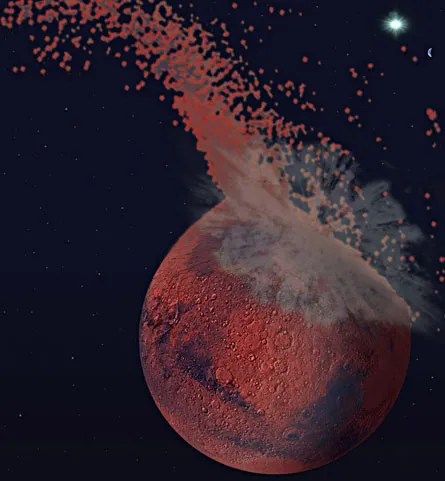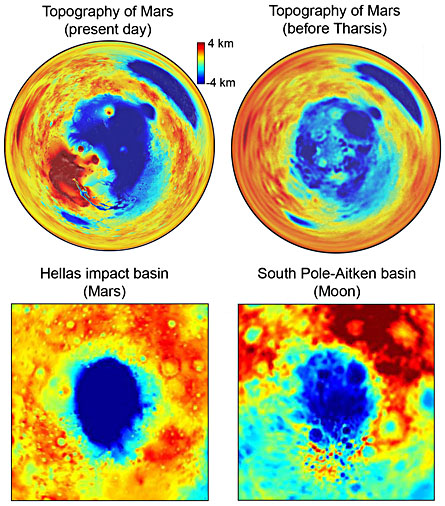- More than 2 years ago
Mars has two faces: a northern hemisphere where the ground is smooth and low, and a southern hemisphere of high elevation and many craters.


“It’s weird. It’s one of the really striking things about the planet,” says Steven Squyres, a planetary scientist at Cornell University. “But if we are going to understand Mars, we need to understand its dichotomy.”
Now, three papers published in the June 26 Nature provide an explanation.
“Something big,” says Francis Nimmo, a lead author on one of the studies and a University of California, Santa Cruz planetary scientist, “smacked into Mars and stripped half the crust off the planet.”
In 1984, Squyres and now retired astrogeologist Don E. Wilhelms suggested that a single impact could cause the Martian surface to split, almost down the middle. The impact hypothesis was an alternative to the idea that internal Martian processes or multiple asteroid impacts made the northern hemisphere 4 kilometers lower and gave it a thinner crust than the southern hemisphere. It was inspired by a theory developing at the time, and now more widely accepted, that Earth’s moon formed when a large impact broke off a chunk of the planet.
But, “we didn’t do any detailed calculations. We simply proposed the impact idea,” says Squyres, who was not involved in the latest research. “For 25 years, it just sat there.”
Now, he explains, the new studies “lend some real quantitative rigor to the idea” that an asteroid or comet hit Mars roughly 4 billion years ago.
The first team, using data from two Mars orbiters, mapped the surface elevations, crustal thicknesses and variations in gravitational pull of the entire planet’s surface. That analysis enabled the scientists to essentially peel back the newer layers of volcanic rock and see underneath to the ancient surface of the Red Planet’s northern hemisphere, says Jeffrey Andrews-Hanna, a postdoctoral planetary scientist at MIT and lead author on the team’s paper. The results unveiled a gigantic, smooth pockmark that traces the border between Mars’ two faces and is projected to cover 40 percent of the planet’s surface.
“Finding this elliptical boundary is a smoking gun,” Andrews-Hanna says. “There is only one known way to get a shape like this: Impact.”
Projected to be 10,600 kilometers long and 8,500 kilometers wide — roughly equivalent to the combined area of Asia, Europe and Australia — this mammoth crater now takes its place as the largest known crater in the solar system.
It also looks similar when closely compared with other massive cavities, such as the Hellas basin on Mars or the South Pole-Aitken basin on the moon — except that it’s four times larger than either of them, Andrews-Hanna explains.
When Squyres and Wilhems identified part of the cavity in the 1980s, they dubbed it BorealisBasin. Because about a third of its edge is hidden under layers of lava flows, Andrews-Hanna says, no one had mapped the entire Martian scar, until now.
“This data should change the tide of scientific opinion about what shaped the surface of Mars. All the evidence we have now agrees best with the impact scenario,” the MIT researcher says, “especially after you consider the other two papers.”
The other two groups aimed to model where an impactor could have hit and how large it could have been. These two teams knew from observations similar to Andrews-Hanna’s that they needed to show how an impact event could result in a Martian surface with a huge cavity in the northern hemisphere. An impact would melt a planet’s surface wherever it hit, and the simulation would have to leave Mars with a thin crust in the north and thicker crust in the south, Nimmo, lead author of the third paper, explains.
Knowing this, the two teams simulated slamming different-sized objects into Mars to pinpoint the “sweet spot” conditions that could gouge out such a large scar but not melt the entire crust of the planet or create a standard crater rim, says Caltech graduate student Margarita Marinova, lead author on the other modeling paper.
The newly identified Martian cavity does not have a crater rim, possibly because the impactor was so big that, when it hit, it ejected material over a large part of the Martian surface rather than in just a small ring around the crater, she says.
Working independently from Andrews-Hanna, both teams successfully hit the “sweet spot,” nearly matching the observations of the impact cavity’s size and location that Andrews-Hanna’s team report.
Also, the two modeling teams independently concluded that the impactor had to be between one-tenth and two-thirds the size of the moon to create Mars’ two-faced surface.
“The model calculations are solidly done, and the observations are good. They do not prove by a shadow of a doubt that this is how this planet’s dichotomy formed,” Squyres says. “But it’s nice to see an old idea dusted off and turned into something with real physical plausibility.”




